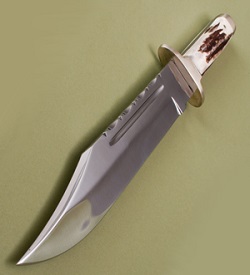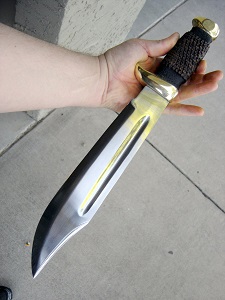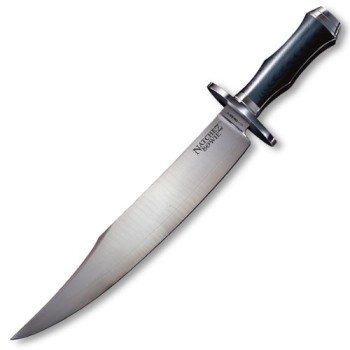This article contains affiliate links. If you make a purchase after clicking on a link I may earn a small commission at no extra cost to you.
 There are many different types of knives available on the market and each of them has their own particular features that make them most useful for one or two specific purposes. Hunting knives, fighting knives and multi-purpose knives are the most common categories of knives being purchased today. Some of them are actively used for a predetermined purpose while others are basically kept by the owner as a weapon of self-defense or as a collectible showpiece. There are even types of knives that have been outlawed in some principalities due to security reasons.
There are many different types of knives available on the market and each of them has their own particular features that make them most useful for one or two specific purposes. Hunting knives, fighting knives and multi-purpose knives are the most common categories of knives being purchased today. Some of them are actively used for a predetermined purpose while others are basically kept by the owner as a weapon of self-defense or as a collectible showpiece. There are even types of knives that have been outlawed in some principalities due to security reasons.
Bowie Knife History
Around the 19th century, an admired Colonel in the Texas militia known as James “Jim” Bowie was a ruthless and fearless leader in several major battles of the Texas Revolution. Even after his noble death at the Battle of the Alamo, Jim Bowie was credited with military victories, rallying morale of troops and the invention of the Bowie knife.
The first use of this clip point knife certainly dates back to the 1830s, which could place the design within the same time frame as Jim Bowie. The famous knife style quickly became a favorite among soldiers in battle because it was easy to carry and sheath, plus it held special importance as the memorial of a famous and respected war leader.
James Black capitalized on the original design and soon there were several knives with unique modifications that could easily be customized by soldiers on the field. Jim Bowie originally made the style famous at the Sandbar Fight when he used a large knife with a long blade to defeat enemy soldiers. Some of the infamous characteristics, like the long blade and cross guard, were always present on the Bowie style knives. This was no doubt a tribute to the famed American leader, businessman and solider of the Texas Revolution.
Features of the Bowie Knife
Rather than being one specific blade design, the “bowie knife”actually refers to a general style of knife and this term came to be synonymous with long, clip point knives. These blades were typically associated with Spanish hunting or butcher knives because of the length and piercing point. The cross guard handle allowed the user to keep a stead grip without risking inadvertent hand injury amid a battle or hunting encounter.
The clip point blade is named because of the curvature of the tip which appears as if about one third of the blade tip was clipped off. There are three basic types of knife blades, each with a unique purpose. The drop point is a heavier blade with a thicker tip that is commonly used to cut through tough, fleshy surfaces.
The spear point is so named after the pointed, spear-like point that is basically an extension of the center axis of the long blade. The clip point style such as the Bowie knife is represented by a thinner blade with a sharp, pointy tip and low friction that helps with fast motion tasks. Another benefit of the clip point knife is a variation that includes a sharpened edge on the curved or clipped out part. This additional feature can be used as a multi-purpose tool, a sharpener for other knives or a paring knife for fruits and vegetables.
A Bowie knife handle can be made of several different materials. Crude metals, copper and wood were often the only items available during the early 19th century. Many knives were carved and fashioned using whatever products could be found and repurposed. This was especially common during wartime when soldiers were often losing or breaking weapons and they needed fast replacements. Today, mass production allows knife handles to be automatically riveted into place around a predetermined blade size. Longer blade lengths usually require thicker handles to provide the best control and torque for the user. Shorter blade lengths will have varying size handles but they are usually more rounded in shape to provide the user with the maximum amount of control. Blade handles can be made of plastic, wood, rubber, metal or many other materials. Users often have custom made handles that are ridged or padded on the interior to provide comfort and control during use.
List Of The Best Bowie Knives
Cold Steel 16ABSJ Natchez Bowie
 Cold Steel 16ABSJ Natchez Bowie is a very impressive knife, it is also very large knife:-
Cold Steel 16ABSJ Natchez Bowie is a very impressive knife, it is also very large knife:-
- Blade: 11 3/4″
- Overall: 17 1/8″
- Weight: 19.9 oz.
- Steel: VG-1 San Mai III
We are referring to knife in a completely different price bracket, at just under the $1600 price point. At this price you have every right to demand excellence in quality of design and of manufacture. From reading the reviews these high demands have been met.
The knife is very well balanced. Fit and finish are just outstanding, the grind lines are straight, the San Mai III steel line is very noticeable even on the spine you can see the 3 layers very clearly. The satin finish on the blade is very nicely done and the polishing of the guard and pommel is also very good. The handle is very nicely done and it affords a very secure grip, the double coffin shape is excellent. The sheath is very high quality and nicely done.






Comments are closed.